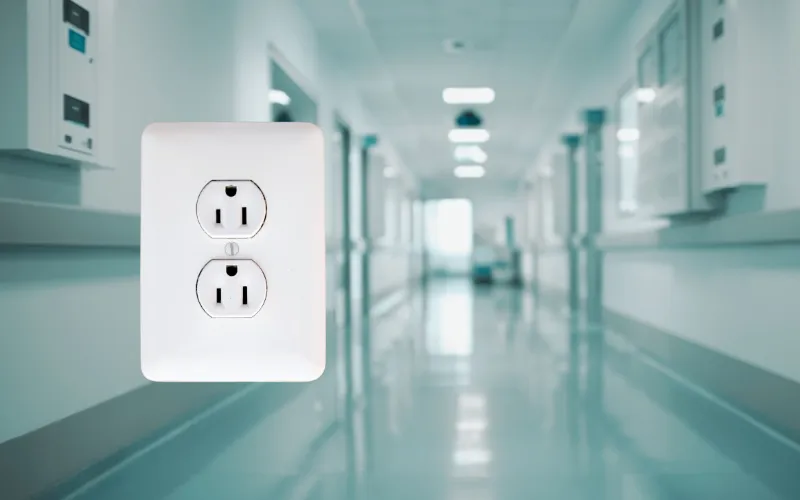Why Are Outlets Upside Down In Hospitals
In hospitals’ complex and critical environments, every detail, from the largest machines to the smallest outlets, is designed with safety and functionality in mind. One peculiar aspect that often catches the eye of visitors and patients alike is the orientation of electrical outlets, which seem to be installed “upside down” compared to standard practices in residential homes.
This article delves into the reasons behind this unconventional placement, exploring how safety protocols, equipment design, and practicality contribute to this choice.
Safety First: Reducing Risk in Hospital Settings
The Logic Behind the Inversion
The primary reason outlets are inverted in hospitals is safety concerns. In a medical environment, where life-saving equipment is continuously used, the risk of electrical accidents is significantly higher than in a domestic setting.
By installing outlets upside down, with the ground pin at the top, hospitals aim to minimize the risk of short circuits. This configuration ensures that if a plug partially falls out of the socket, the live and neutral pins are less likely to come into contact with any metal objects, like a fallen piece of equipment, which could lead to a short circuit or even a fire.

Compatibility with Hospital-Grade Plugs
Hospital-grade plugs and outlets are designed to adhere to stricter safety standards than those used in residential settings. These plugs often have a unique shape or design that fits more securely into the upside-down outlets, reducing the likelihood of accidental disconnections.
This tight fit is crucial in ensuring medical equipment remains operational, especially during emergencies.
Practical Reasons Behind the Orientation
Enhancing Equipment Efficiency
The upside-down installation of outlets in hospitals also serves a practical purpose. Medical devices and equipment often have cords to align with this orientation, facilitating a more organized and efficient setup.
This alignment helps manage the wires in hospital rooms, reduce tripping hazards, and maintain a clutter-free environment, essential for patient safety and staff mobility.
Standardization Across Facilities
Another reason for the uniform upside-down installation of outlets in hospitals is standardization. Having a consistent layout across different rooms and facilities simplifies the job of healthcare professionals who move from room to room and from one hospital to another.
This consistency helps reduce errors, save time, and improve overall efficiency in a high-stress environment.
What Is The Green Dot On Hospital Outlets?
The green dot on hospital outlets signifies they are connected to the hospital’s emergency power system. This means that in the event of a power outage, these outlets will continue to receive power from a backup source, such as a generator.
This is crucial for ensuring that essential medical equipment continues to function during emergencies, helping to maintain patient care and safety.
Do Upside-Down Outlets Have Any Drawbacks In Terms Of Maintenance Or Usability In Hospital Settings?
Upside-down outlets are primarily designed for enhanced safety and specific equipment compatibility in hospital settings. However, they can have minor drawbacks in terms of maintenance or usability. For instance, this orientation might be unfamiliar to new staff or visitors, potentially causing confusion or incorrect use.
Maintenance staff may also need specialized training to handle these outlets properly, especially when performing repairs or inspections, as the design differs from standard residential outlets. However, the benefits of increased safety and equipment reliability in critical healthcare environments significantly outweigh these minor inconveniences.
How Can The Use Of A Multimeter In A Hospital Setting Help Ensure The Safety Of Electrical Installations?
In a hospital setting, where the reliability and safety of electrical systems are paramount, a multimeter plays a crucial role. It allows for testing and verifying electrical outlets and circuits, ensuring they operate within safe parameters.
By measuring voltage, resistance, and continuity, a multimeter can help detect potential issues like voltage fluctuations or faulty wiring, which are critical in environments that rely heavily on medical equipment. This proactive approach to maintenance ensures that all electrical installations function safely and effectively, preventing electrical hazards and ensuring the continuous operation of life-saving equipment.
Conclusion
The inverted orientation of hospital outlets is a thoughtful safety and practicality measure rather than a mere oddity. By understanding the reasons behind this choice, we can appreciate the meticulous attention to detail that goes into hospital design, which aims to ensure patients and healthcare workers’ safety, efficiency, and well-being.
While it might seem trivial at first glance, the direction an outlet faces in a hospital setting could significantly affect safety and functionality.
Frequently Asked Questions
Are upside-down outlets only used in hospitals?
While more common in hospitals, upside-down outlets can also be found in settings where safety and equipment compatibility are priorities, such as laboratories and industrial sites.
Do upside-down outlets affect the functionality of electrical devices?
No, the orientation of the outlet does not affect the performance or functionality of plugged-in devices. The design is solely for safety and practicality.
Can I install upside-down outlets in my home for safety?
While you can install outlets in any orientation in your home, it’s essential to consult with a licensed electrician to ensure that it complies with local building codes and safety standards.

Author
Alex Klein is an electrical engineer with more than 15 years of expertise. He is the host of the Electro University YouTube channel, which has thousands of subscribers.
